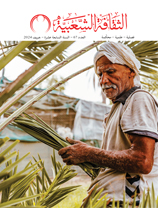Ethnography of Traditional Medicine
Issue 23

Man has always made an effort to maintain good health and to be free of ailments. He has aspired to control disease and anything that prevents the body from carrying out its functions so - since ancient times - he has used methods of treatment that vary among cultures. This has resulted in what the French researcher Benoit called the plurality of medical systems, which has been confirmed both historically and anthropologically. Currently, this plurality can be classified into modern systems and traditional systems.

This study attempts to look into the sociological and anthropological conditions that contribute to traditional medicine’s survival in spite of the dominance of modern medical institutions.
This study attempts to discover how traditional medicine is used to treat sciatica in Morocco, what gives this treatment legitimacy, elements of traditional medical practice, and traditional medicine’s relationship with the modern medical system.
The WHO Traditional Medicine Strategy 2002–2005 defines traditional medicine as a comprehensive term used to refer both to systems such as traditional Chinese medicine, Indian ayurveda and Arabic medicine, and to various forms of indigenous medicine. The term also includes all forms of traditional treatment - such as spiritual therapies or manual therapies such as acupuncture - in addition to medication therapies that involve the use of herbal medicines, animal parts or minerals.
After a long wait, this definition was adopted when WHO decided to recognise traditional medicine at the Alma Ata Conference on Primary Healthcare in 1978. The Conference’s slogan was Health For All 2000.
This paper focuses on different aspects of the traditional treatment for sciatica in Morocco, including the way the treatment is administered, social legitimacy, the nature of sciatica and the traditional treatment’s relation to modern medicine.
The Moroccans have created a collaborative system that structures the relationships among the patients and those among the patients and the healer and his assistants.
The treatment is legitimised by the religious view that - with practices such as phlebotomy, hot massages, and the use of Henna - it is akin to Prophetic Medicine. The cure is a result of the healer’s blessing, his knowledge about the ailment, and the patient’s faith.
The community members’ belief that modern medicine cannot heal sciatica legitimises traditional medicine and ensures its survival.
Yunus Lukili
Morocco




































































